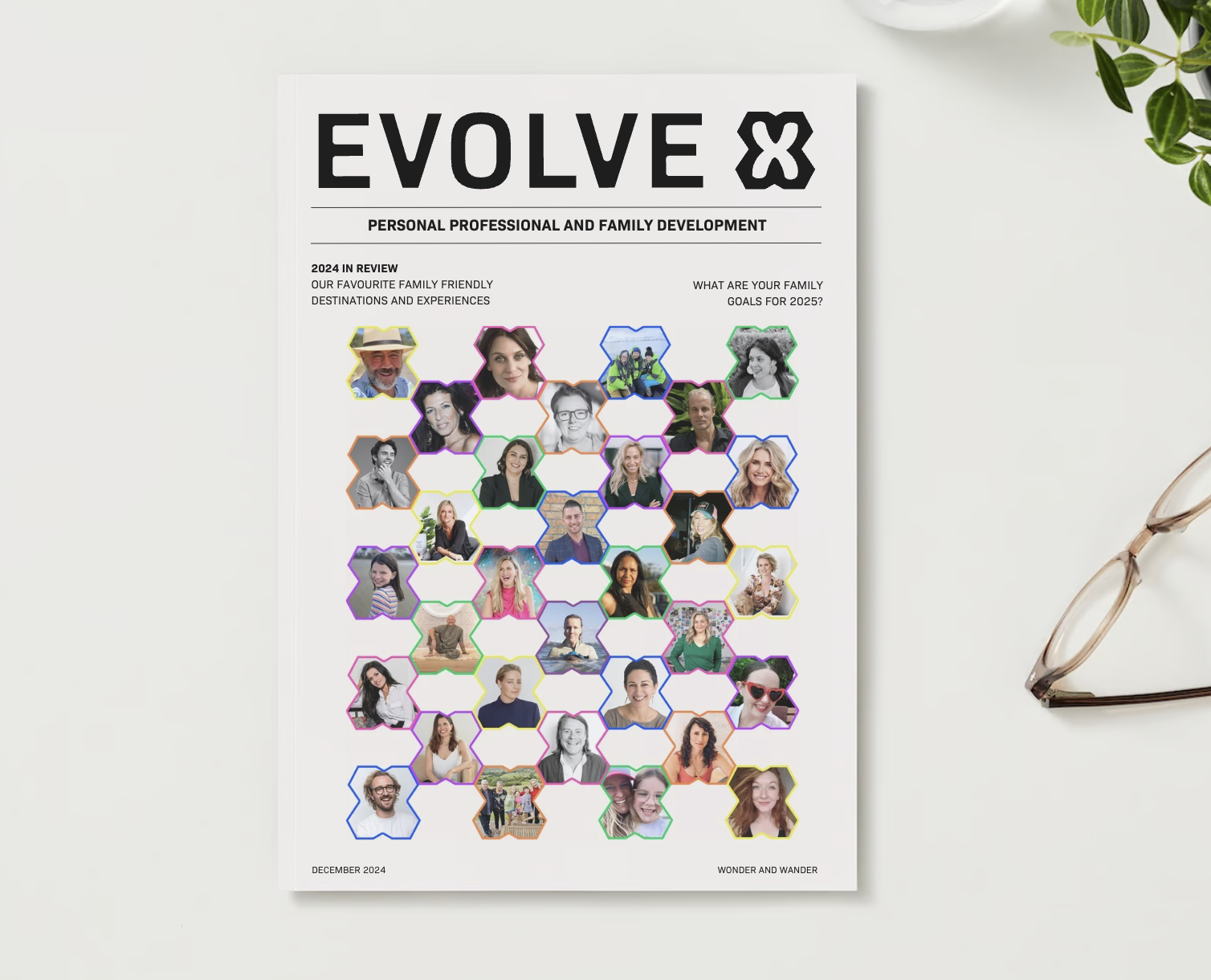THE FUTURE OF COMMUNITY, REIMAGINED.
Evolve X by Wonder and Wander is a high-impact platform designed to empower entrepreneurs, visionaries, and changemakers with the tools, knowledge, and support they need to build sustainable, thriving businesses.

THE FUTURE OF COMMUNITY, REIMAGINED
Evolve X is a high-impact platform designed to empower entrepreneurs, visionaries, and changemakers with the tools, knowledge, and support they need to build sustainable, thriving businesses.


Every step you take with Evolve X creates global impact.
When you join Evolve X, you’re not just transforming your life—you’re changing the world. Every email, booking, every session, and every interaction funds life-changing projects aligned with the UN Sustainable Development Goals, from planting trees to providing education and clean water. Together, we grow, give, and evolve.


Every step you take with Evolve X creates global impact.
When you join Evolve X, you’re not just transforming your life—you’re changing the world. Every email, booking, every session, and every interaction funds life-changing projects aligned with the UN Sustainable Development Goals, from planting trees to providing education and clean water.
Together, we grow, give, and evolve.

Our Services
At Evolve X, we believe in designing a life and business that thrives—where individuals, families, and leaders come together to unlock their fullest potential. Through immersive experiences, powerful coaching, and a global network of changemakers, we create spaces where growth is inevitable, joy is abundant, and impact is limitless.
Are you ready to evolve?


MASTERMIND
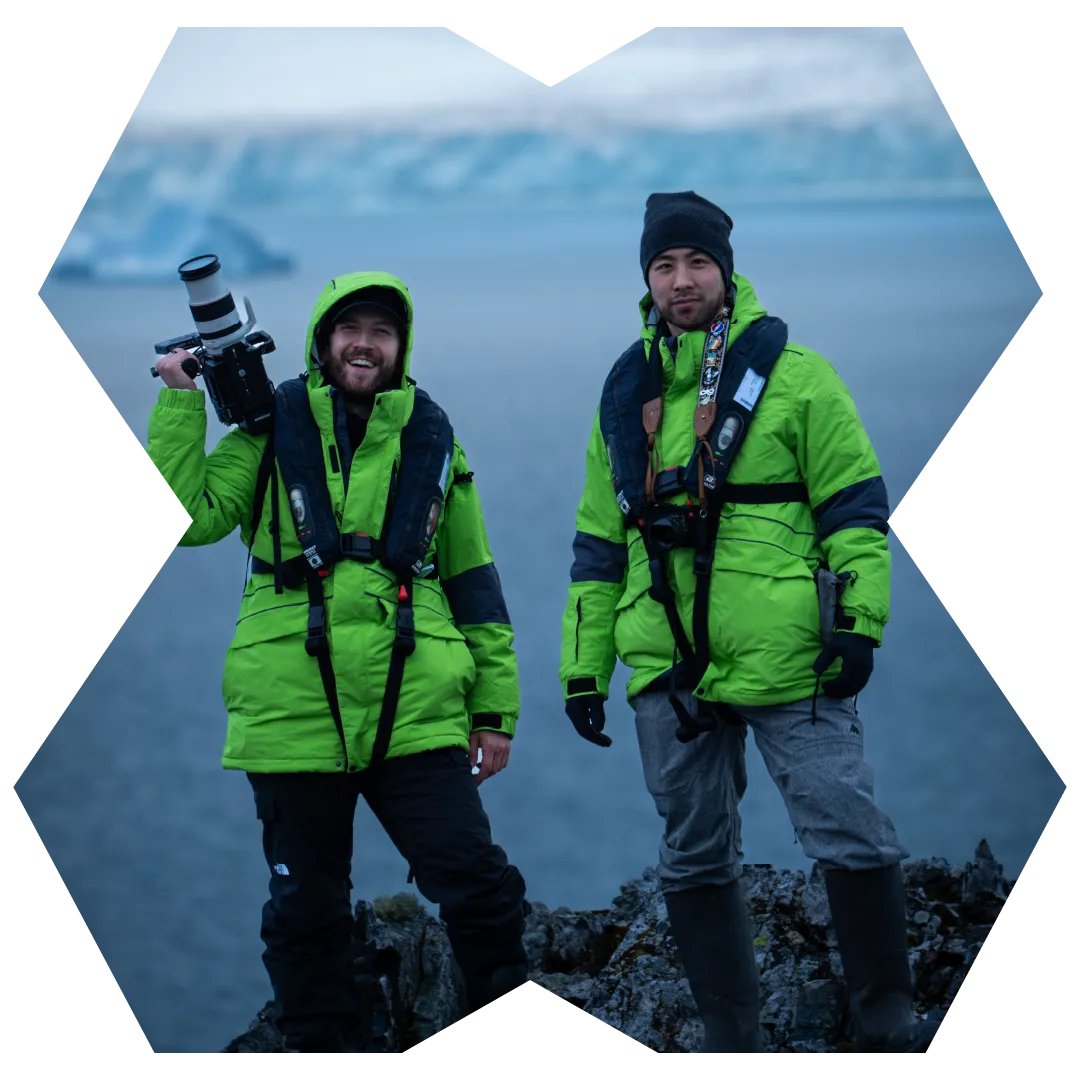

BUSINESS


EXPERIENCES


COMMUNITY
Our 12 Month Mastermind is a blend of Personal and Professional Development for You AND Your Family. We know that when we discover together, we evolve together.
Our frameworks and philosophies are able to be applied in micro businesses to scale-ups and enterprises, Explore a Fractional Growth Partner Model to accelerate or innovate today.
From Antarctica to Uluru we have incredible travel experiences that are designed with Personal and Professional Development at the core. Discover yourself while exploring this incredible planet of ours.
Our Community started as SHE EVOLVES and then We EVOLVED, Our Radically Inclusive Business Community invites ambitious business leaders with family to connect, create, evolve together.
Our Services
Connections are our jam, we can't wait to connect you with ideas, services solutions that will help you EVOLVE.
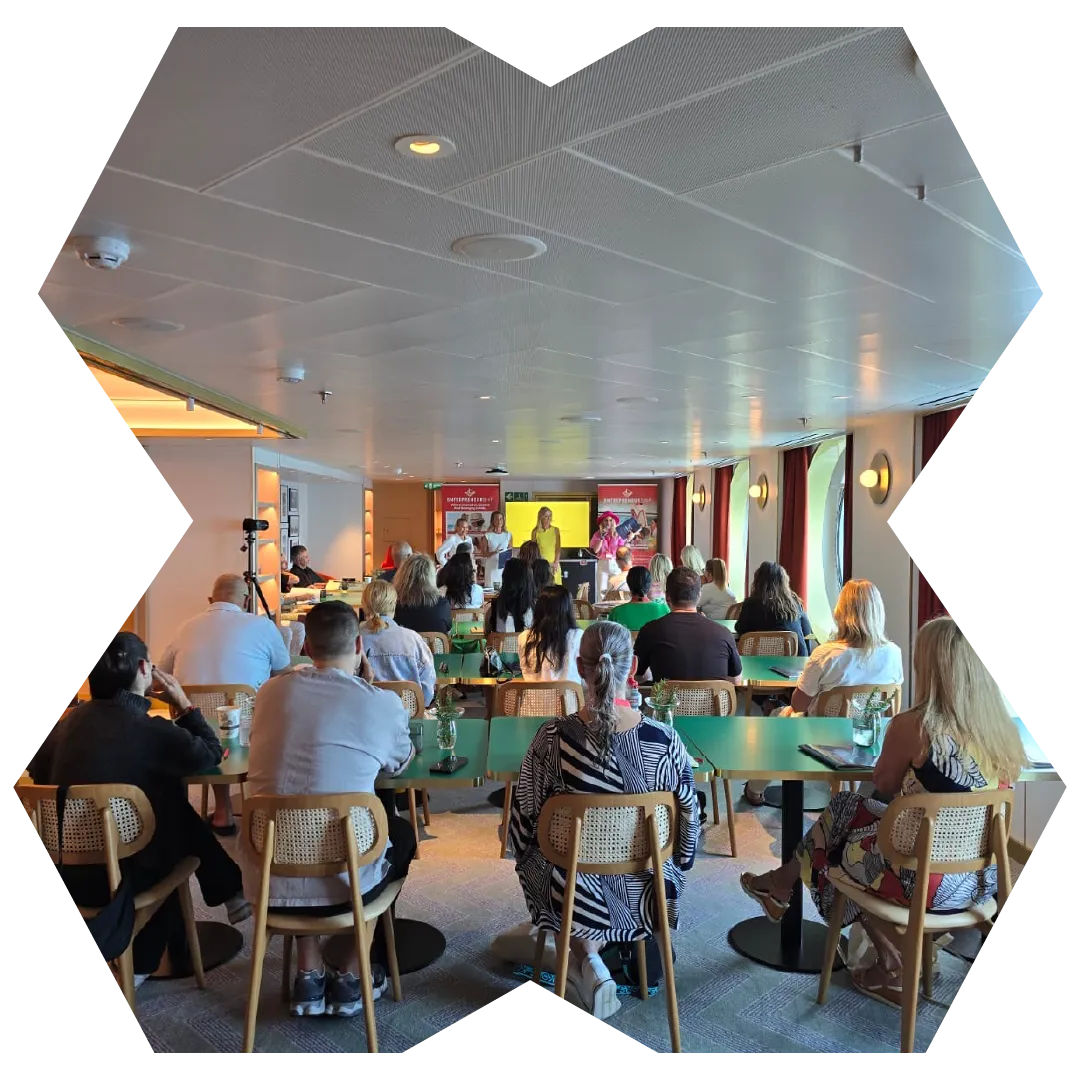

MASTERMIND
Our 12 Month Mastermind is a blend of Personal and Professional Development for You AND Your Family. We know that when we discover together, we evolve together


BUSINESS
Our frameworks and philosophies are able to be applied in micro businesses to scale-ups and enterprises.


EXPERIENCES
From Antarctica to Uluru we have incredible travel experiences that are designed with Personal and Professional Development at the core. Discover yourself while exploring this incredible planet of ours.


COMMUNITY
We are a radically inclusive and contemporary community for business owners, leaders and their extended families.
Who We Serve
“We’re not here to escape life. We’re here to reimagine it.”
We were raised in a world that rewarded output, obedience, and overachievement. But something inside us always knew… we were here to create something
different.
At Evolve X, we:
Break free from the scorecard and performative success
Reimagine metrics that feel good and do good
Cultivate genuine connection and clarity
Build regenerative businesses and beautiful lives
Welcome every identity, expression, and evolution of human potential
Whether you’re here as a founder, a family, a couple, a corporate rebel, or a burnt-out creative—
you belong.
WANT MORE HELP
GROWING YOUR BUSINESS?
Talk to us about our growth partnership models
Every time something good happens in our business, Something great happens in our world.


PAST Communities We Created
We have 20 years experience producing retreats, experience and events to form communities from team days for 5 people to audiences of 3,000. Over 30,000 people have experienced a life changing experience that we had the pleasure of designing.
Communities We Created
We have 20 years experience producing retreats, experience and events to form communities from team days for 5 people to audiences of 3,000. Over 30,000 people have experienced a life changing experience that we had the pleasure of designing.
CLIENTS WE HAVE WORKED WITH
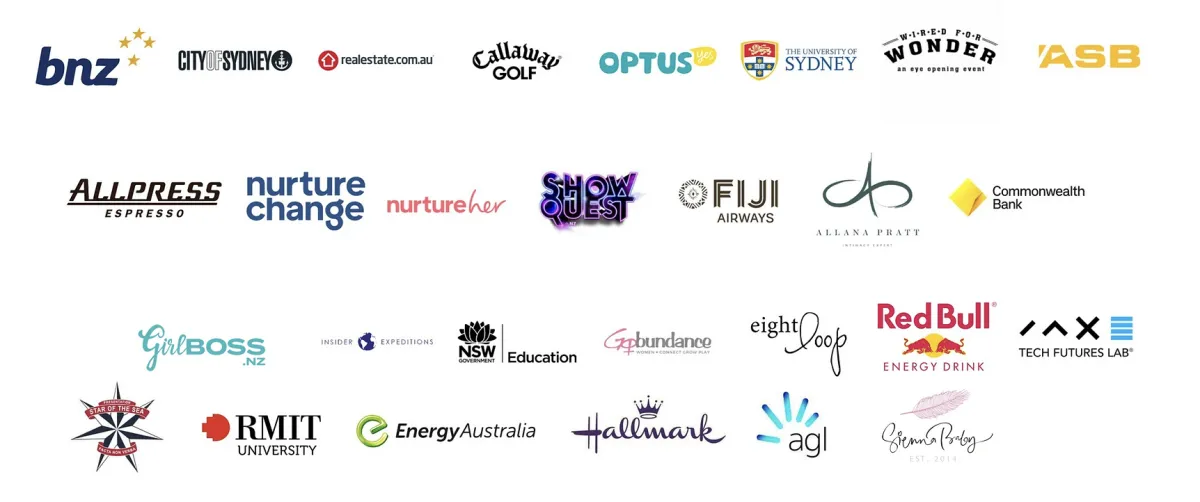
News & Stories

Whitepaper: Burnout: Understanding Causes, Impacts, and Interventions in Australia and New Zealand
Burnout: Understanding Causes, Impacts, and Interventions in Australia and New Zealand
Executive Summary
This white paper examines burnout as an occupational phenomenon, focusing on its causes, relationships with neurodiversity and gender, and prevalence in Australia and New Zealand. Drawing on recent research and systematic reviews, we provide evidence-based insights to inform prevention and recovery strategies. Key findings indicate that workplace factors such as high demands and low control significantly contribute to burnout, with neurodivergent individuals facing unique challenges. Gender differences in burnout manifestation are also observed, with nearly half of employees in Australia and New Zealand reporting burnout symptoms. These insights can guide the development of targeted interventions across various sectors, particularly in high-risk industries like retail.
Introduction
Burnout has emerged as a significant occupational health concern affecting workforce productivity, well-being, and retention. The World Health Organization (WHO) recognizes burnout in the International Classification of Diseases (ICD-11) as an occupational phenomenon resulting from chronic workplace stress that has not been successfully managed. It is characterized by three dimensions:
Feelings of energy depletion or exhaustion
Increased mental distance from one's job (cynicism or negativism)
Reduced professional efficacy
This white paper synthesizes current research on burnout, examining its causes, relationships with neurodiversity and gender, and specific data from Australia and New Zealand. By providing evidence-based insights, we aim to support the development of effective prevention and recovery strategies.
Scientific Understanding of Burnout
Definition and Classification
The WHO's inclusion of burnout in ICD-11 represents a significant step in its recognition as a workplace phenomenon. Importantly, burnout is not classified as a medical condition but appears in the chapter "Factors influencing health status or contact with health services." This classification emphasizes its workplace context and distinguishes it from conditions like adjustment disorder or anxiety disorders.
The 2019 update to the definition explicitly limits burnout to the occupational context, excluding its application to other life areas. This distinction is crucial for developing targeted interventions that address workplace-specific factors.
Evidence-Based Causes
Systematic reviews provide strong evidence linking workplace factors to burnout. A comprehensive meta-analysis published in BMC Public Health (2017) examined studies from Europe, North America, Australia, and New Zealand between 1990-2013, identifying key work environment factors associated with burnout symptoms.
Table 1: Key Workplace Factors Associated with Emotional Exhaustion
Work Factor
Evidence Grade
Weighted Odds Ratio (95% CI)
Number of Studies
Low Job Control
Moderate
1.63 (1.53 to 1.75)
9
High Job Demands
Limited
2.53 (2.36 to 2.71)
11 (of 13)
Emotional Demands
Limited
2.95 (2.40 to 3.62)
4 (of 5)
Low Workplace Support
Moderate
1.81 (1.68 to 1.95)
7
High Workload
Limited
4.22 (3.50 to 5.11)
5 (of 7)
Low Reward
Limited
1.86 (1.37 to 2.52)
2
Job Insecurity
Limited
1.39 (1.22 to 1.57)
3
Workplace Justice (Protective)
Limited
0.35 (0.27 to 0.45)
3
These findings highlight the demand-control-support model as central to understanding burnout. Job control and support serve as protective factors, while high demands increase risk. The evidence for physical, chemical, and biological factors was insufficient, with no studies meeting quality criteria for chemical/biological factors and only one for physical environment.
Neurodiversity and Burnout
Neurodivergent individuals, particularly those with autism and ADHD, experience a distinct form of burnout often termed "neurodivergent burnout." This phenomenon presents unique challenges and requires specialized interventions.
Manifestation in Neurodivergent Individuals
A 2024 article from Medical News Today highlights that neurodivergent burnout may cause:
Chronic exhaustion
Increased sensory sensitivity
Loss of skills
Reduced tolerance to stimuli
Negative health effects
Reduced independence and quality of life
Increased risk of suicidal behavior
For individuals with ADHD, a 2022 study noted additional symptoms:
Reduced quality of life
Persistent anxiety and stress
Feeling overwhelmed and "weathered"
Physical health issues
Unique Causal Factors
General Neurodivergent Factors:
Masking or hiding neurodiverse traits
Navigating daily stressors that present additional challenges
Dealing with societal lack of awareness and acceptance
Experiencing discrimination and stigma
Autism-Specific Factors:
Prolonged stress from trying to act non-autistic
Unreachable expectations
Unaccommodating environments
Dismissal of needs
Lack of appropriate services or boundaries
ADHD-Specific Factors:
Difficulty balancing life demands
Higher risk of mental illness
Hyperfocus leading to overworking
Need for compensation strategies
Challenges with inattentiveness (procrastination, perfectionism)
Issues with impulsivity and hyperactivity
Difficulties with relaxation
Recovery Strategies
Research suggests several effective recovery strategies for neurodivergent individuals:
Accepting one's neurodiversity
Seeking social support
Taking time off
Reducing expectations
Unmasking (being authentic)
Connecting with similar individuals
Prioritizing accepting relationships
Seeking workplace adjustments
Taking regular breaks
Reducing stress
Consulting healthcare professionals
Maintaining a healthful lifestyle
Early recognition of symptoms
For neurodivergent children, additional strategies include:
Understanding energy limits
Scheduling rest periods
Allowing unmasking
Filling learning gaps
Developing organization systems
Modifying routines as needed
Spending time in nature
Gender Differences in Burnout
Research challenges the common belief that women are more likely to experience burnout overall. A 2010 meta-analysis published in the Journal of Vocational Behavior, analyzing 409 effect sizes from 183 studies, revealed nuanced gender differences in burnout manifestation:
Women experience slightly more emotional exhaustion than men (effect size δ = .10)
Men exhibit somewhat more depersonalization than women (effect size δ = −.19)
These effects, while small, are practically significant. Moderator analyses showed larger gender differences in the USA compared to the EU, with no significant variation across male-typed versus female-typed occupations.
The analysis suggests discontinuing overall burnout measures, as they align primarily with emotional exhaustion, highlighting the need for dimension-specific assessments. This distinction is crucial for developing gender-sensitive interventions that address the unique ways burnout manifests across genders.
Burnout in Australia and New Zealand
Recent data provide insights into the prevalence and impact of burnout specifically in Australia and New Zealand.
Prevalence and Impact
According to a 2023 report by Sonder and a McGregor Tan survey of 2,007 employees working at least 30 hours per week:
49% of employees report feelings of burnout or exhaustion
35% took time off for mental health in the past year
8% took no time off at all despite experiencing symptoms
Regarding holiday impact:
43% reported slightly or significantly increased wellbeing during holidays
29% reported no difference in wellbeing
27.5% reported slightly or significantly worse wellbeing during holidays
Sector-Specific Data
An unexpected finding reveals that retail workers account for 49% of stress support cases from January 2022 to February 2024, indicating significant sector-specific pressures. This highlights the need for targeted interventions in industries with heightened burnout risk.
Economic Impact
The economic consequences of burnout are substantial. According to Gallup's 2023 "State of the Global Workplace Report," burnout-related absenteeism costs Australia approximately $14 billion annually. Specific economic data for New Zealand was not available in the reviewed sources.
Historical data from a 2021 SmartCompany article noted that 77% of workers experienced burnout in 2020, reflecting the toll of COVID-19 and remote work. While this represents an older figure, it illustrates the significant impact of global crises on burnout rates.
Implications for Prevention and Recovery
The comprehensive evidence presented in this white paper has several implications for developing effective burnout prevention and recovery programs:
Workplace Interventions
Enhance job control: Given the strong association between low job control and burnout, interventions should focus on increasing employee autonomy and decision-making authority.
Manage demands: Organizations should implement strategies to moderate workload and emotional demands, which show some of the strongest associations with burnout.
Foster supportive workplaces: As workplace support serves as a protective factor, cultivating supportive management practices and peer relationships is essential.
Promote workplace justice: Fair treatment and procedural justice can significantly reduce burnout risk.
Neurodiversity-Focused Approaches
Reduce masking pressure: Create inclusive environments where neurodivergent individuals feel accepted without having to hide their traits.
Provide accommodations: Implement reasonable adjustments based on individual needs.
Develop tailored support: Recognize the unique burnout experience of neurodivergent individuals and offer specialized resources.
Raise awareness: Educate workplaces about neurodiversity to reduce stigma and discrimination.
Gender-Sensitive Strategies
Address dimension-specific experiences: Recognize that women may need more support for emotional exhaustion, while men may benefit from interventions targeting depersonalization.
Avoid one-size-fits-all approaches: Develop gender-sensitive assessment tools and interventions that acknowledge different manifestations of burnout.
Regional Considerations
Target high-risk sectors: Given the disproportionate impact on retail workers in Australia and New Zealand, develop sector-specific interventions.
Address holiday effectiveness: With over a quarter of employees reporting worse wellbeing during holidays, explore more effective recovery strategies beyond time off.
Economic case: Use regional economic impact data to advocate for organizational investment in burnout prevention.
Conclusion
Burnout represents a significant occupational health challenge with complex causes and manifestations. This white paper has synthesized current evidence on burnout's relationship with workplace factors, neurodiversity, gender, and its specific impact in Australia and New Zealand.
The evidence points to several key conclusions:
Burnout is primarily driven by workplace factors, particularly high demands and low control.
Neurodivergent individuals face unique burnout challenges requiring specialized interventions.
Gender influences how burnout manifests, with women experiencing more emotional exhaustion and men more depersonalization.
In Australia and New Zealand, burnout affects nearly half of all employees, with particularly high rates in the retail sector.
These insights can inform the development of evidence-based prevention and recovery programs tailored to organizational, individual, and regional needs. By addressing the specific factors identified in this white paper, organizations can create healthier work environments that reduce burnout risk and promote sustainable performance and wellbeing.
References
World Health Organization. (2019). Burn-out an "occupational phenomenon": International Classification of Diseases.
American Medical Association. (2019). WHO adds burnout to ICD-11: What it means for physicians.
BMC Public Health. (2017). A systematic review including meta-analysis of work environment and burnout symptoms.
Medical News Today. (2024). Neurodivergent burnout: Symptoms, causes, and recovery.
Journal of Vocational Behavior. (2010). Gender differences in burnout: A meta-analysis.
Sonder. (2023). Burnout report.
SmartCompany. (2021). Majority of Aussie and NZ workers experienced burnout in 2020.
Gallup. (2023). State of the Global Workplace Report.
Prepared By Sarah Pirie-Nally

Whitepaper: Burnout: Understanding Causes, Impacts, and Interventions in Australia and New Zealand
Burnout: Understanding Causes, Impacts, and Interventions in Australia and New Zealand
Executive Summary
This white paper examines burnout as an occupational phenomenon, focusing on its causes, relationships with neurodiversity and gender, and prevalence in Australia and New Zealand. Drawing on recent research and systematic reviews, we provide evidence-based insights to inform prevention and recovery strategies. Key findings indicate that workplace factors such as high demands and low control significantly contribute to burnout, with neurodivergent individuals facing unique challenges. Gender differences in burnout manifestation are also observed, with nearly half of employees in Australia and New Zealand reporting burnout symptoms. These insights can guide the development of targeted interventions across various sectors, particularly in high-risk industries like retail.
Introduction
Burnout has emerged as a significant occupational health concern affecting workforce productivity, well-being, and retention. The World Health Organization (WHO) recognizes burnout in the International Classification of Diseases (ICD-11) as an occupational phenomenon resulting from chronic workplace stress that has not been successfully managed. It is characterized by three dimensions:
Feelings of energy depletion or exhaustion
Increased mental distance from one's job (cynicism or negativism)
Reduced professional efficacy
This white paper synthesizes current research on burnout, examining its causes, relationships with neurodiversity and gender, and specific data from Australia and New Zealand. By providing evidence-based insights, we aim to support the development of effective prevention and recovery strategies.
Scientific Understanding of Burnout
Definition and Classification
The WHO's inclusion of burnout in ICD-11 represents a significant step in its recognition as a workplace phenomenon. Importantly, burnout is not classified as a medical condition but appears in the chapter "Factors influencing health status or contact with health services." This classification emphasizes its workplace context and distinguishes it from conditions like adjustment disorder or anxiety disorders.
The 2019 update to the definition explicitly limits burnout to the occupational context, excluding its application to other life areas. This distinction is crucial for developing targeted interventions that address workplace-specific factors.
Evidence-Based Causes
Systematic reviews provide strong evidence linking workplace factors to burnout. A comprehensive meta-analysis published in BMC Public Health (2017) examined studies from Europe, North America, Australia, and New Zealand between 1990-2013, identifying key work environment factors associated with burnout symptoms.
Table 1: Key Workplace Factors Associated with Emotional Exhaustion
Work Factor
Evidence Grade
Weighted Odds Ratio (95% CI)
Number of Studies
Low Job Control
Moderate
1.63 (1.53 to 1.75)
9
High Job Demands
Limited
2.53 (2.36 to 2.71)
11 (of 13)
Emotional Demands
Limited
2.95 (2.40 to 3.62)
4 (of 5)
Low Workplace Support
Moderate
1.81 (1.68 to 1.95)
7
High Workload
Limited
4.22 (3.50 to 5.11)
5 (of 7)
Low Reward
Limited
1.86 (1.37 to 2.52)
2
Job Insecurity
Limited
1.39 (1.22 to 1.57)
3
Workplace Justice (Protective)
Limited
0.35 (0.27 to 0.45)
3
These findings highlight the demand-control-support model as central to understanding burnout. Job control and support serve as protective factors, while high demands increase risk. The evidence for physical, chemical, and biological factors was insufficient, with no studies meeting quality criteria for chemical/biological factors and only one for physical environment.
Neurodiversity and Burnout
Neurodivergent individuals, particularly those with autism and ADHD, experience a distinct form of burnout often termed "neurodivergent burnout." This phenomenon presents unique challenges and requires specialized interventions.
Manifestation in Neurodivergent Individuals
A 2024 article from Medical News Today highlights that neurodivergent burnout may cause:
Chronic exhaustion
Increased sensory sensitivity
Loss of skills
Reduced tolerance to stimuli
Negative health effects
Reduced independence and quality of life
Increased risk of suicidal behavior
For individuals with ADHD, a 2022 study noted additional symptoms:
Reduced quality of life
Persistent anxiety and stress
Feeling overwhelmed and "weathered"
Physical health issues
Unique Causal Factors
General Neurodivergent Factors:
Masking or hiding neurodiverse traits
Navigating daily stressors that present additional challenges
Dealing with societal lack of awareness and acceptance
Experiencing discrimination and stigma
Autism-Specific Factors:
Prolonged stress from trying to act non-autistic
Unreachable expectations
Unaccommodating environments
Dismissal of needs
Lack of appropriate services or boundaries
ADHD-Specific Factors:
Difficulty balancing life demands
Higher risk of mental illness
Hyperfocus leading to overworking
Need for compensation strategies
Challenges with inattentiveness (procrastination, perfectionism)
Issues with impulsivity and hyperactivity
Difficulties with relaxation
Recovery Strategies
Research suggests several effective recovery strategies for neurodivergent individuals:
Accepting one's neurodiversity
Seeking social support
Taking time off
Reducing expectations
Unmasking (being authentic)
Connecting with similar individuals
Prioritizing accepting relationships
Seeking workplace adjustments
Taking regular breaks
Reducing stress
Consulting healthcare professionals
Maintaining a healthful lifestyle
Early recognition of symptoms
For neurodivergent children, additional strategies include:
Understanding energy limits
Scheduling rest periods
Allowing unmasking
Filling learning gaps
Developing organization systems
Modifying routines as needed
Spending time in nature
Gender Differences in Burnout
Research challenges the common belief that women are more likely to experience burnout overall. A 2010 meta-analysis published in the Journal of Vocational Behavior, analyzing 409 effect sizes from 183 studies, revealed nuanced gender differences in burnout manifestation:
Women experience slightly more emotional exhaustion than men (effect size δ = .10)
Men exhibit somewhat more depersonalization than women (effect size δ = −.19)
These effects, while small, are practically significant. Moderator analyses showed larger gender differences in the USA compared to the EU, with no significant variation across male-typed versus female-typed occupations.
The analysis suggests discontinuing overall burnout measures, as they align primarily with emotional exhaustion, highlighting the need for dimension-specific assessments. This distinction is crucial for developing gender-sensitive interventions that address the unique ways burnout manifests across genders.
Burnout in Australia and New Zealand
Recent data provide insights into the prevalence and impact of burnout specifically in Australia and New Zealand.
Prevalence and Impact
According to a 2023 report by Sonder and a McGregor Tan survey of 2,007 employees working at least 30 hours per week:
49% of employees report feelings of burnout or exhaustion
35% took time off for mental health in the past year
8% took no time off at all despite experiencing symptoms
Regarding holiday impact:
43% reported slightly or significantly increased wellbeing during holidays
29% reported no difference in wellbeing
27.5% reported slightly or significantly worse wellbeing during holidays
Sector-Specific Data
An unexpected finding reveals that retail workers account for 49% of stress support cases from January 2022 to February 2024, indicating significant sector-specific pressures. This highlights the need for targeted interventions in industries with heightened burnout risk.
Economic Impact
The economic consequences of burnout are substantial. According to Gallup's 2023 "State of the Global Workplace Report," burnout-related absenteeism costs Australia approximately $14 billion annually. Specific economic data for New Zealand was not available in the reviewed sources.
Historical data from a 2021 SmartCompany article noted that 77% of workers experienced burnout in 2020, reflecting the toll of COVID-19 and remote work. While this represents an older figure, it illustrates the significant impact of global crises on burnout rates.
Implications for Prevention and Recovery
The comprehensive evidence presented in this white paper has several implications for developing effective burnout prevention and recovery programs:
Workplace Interventions
Enhance job control: Given the strong association between low job control and burnout, interventions should focus on increasing employee autonomy and decision-making authority.
Manage demands: Organizations should implement strategies to moderate workload and emotional demands, which show some of the strongest associations with burnout.
Foster supportive workplaces: As workplace support serves as a protective factor, cultivating supportive management practices and peer relationships is essential.
Promote workplace justice: Fair treatment and procedural justice can significantly reduce burnout risk.
Neurodiversity-Focused Approaches
Reduce masking pressure: Create inclusive environments where neurodivergent individuals feel accepted without having to hide their traits.
Provide accommodations: Implement reasonable adjustments based on individual needs.
Develop tailored support: Recognize the unique burnout experience of neurodivergent individuals and offer specialized resources.
Raise awareness: Educate workplaces about neurodiversity to reduce stigma and discrimination.
Gender-Sensitive Strategies
Address dimension-specific experiences: Recognize that women may need more support for emotional exhaustion, while men may benefit from interventions targeting depersonalization.
Avoid one-size-fits-all approaches: Develop gender-sensitive assessment tools and interventions that acknowledge different manifestations of burnout.
Regional Considerations
Target high-risk sectors: Given the disproportionate impact on retail workers in Australia and New Zealand, develop sector-specific interventions.
Address holiday effectiveness: With over a quarter of employees reporting worse wellbeing during holidays, explore more effective recovery strategies beyond time off.
Economic case: Use regional economic impact data to advocate for organizational investment in burnout prevention.
Conclusion
Burnout represents a significant occupational health challenge with complex causes and manifestations. This white paper has synthesized current evidence on burnout's relationship with workplace factors, neurodiversity, gender, and its specific impact in Australia and New Zealand.
The evidence points to several key conclusions:
Burnout is primarily driven by workplace factors, particularly high demands and low control.
Neurodivergent individuals face unique burnout challenges requiring specialized interventions.
Gender influences how burnout manifests, with women experiencing more emotional exhaustion and men more depersonalization.
In Australia and New Zealand, burnout affects nearly half of all employees, with particularly high rates in the retail sector.
These insights can inform the development of evidence-based prevention and recovery programs tailored to organizational, individual, and regional needs. By addressing the specific factors identified in this white paper, organizations can create healthier work environments that reduce burnout risk and promote sustainable performance and wellbeing.
References
World Health Organization. (2019). Burn-out an "occupational phenomenon": International Classification of Diseases.
American Medical Association. (2019). WHO adds burnout to ICD-11: What it means for physicians.
BMC Public Health. (2017). A systematic review including meta-analysis of work environment and burnout symptoms.
Medical News Today. (2024). Neurodivergent burnout: Symptoms, causes, and recovery.
Journal of Vocational Behavior. (2010). Gender differences in burnout: A meta-analysis.
Sonder. (2023). Burnout report.
SmartCompany. (2021). Majority of Aussie and NZ workers experienced burnout in 2020.
Gallup. (2023). State of the Global Workplace Report.
Prepared By Sarah Pirie-Nally
IMPACT THAT MATTERS
What Our Community Has To Say
I can't recommend the EvolveX community enough.I thought I was going to have a reset on my busy schedule but wow! I got so much more with the most incredible wāhine energy.

Erica Best
She Evolves Alumni
Taking part in She Evolves by Evolve X was truly a life-changing experience for me. It happened at the perfect time as my family had experienced some challenging events in the time leading up to it. From the moment I stepped off the plane, I could feel the positive energy, love, acceptance and excitement in the air. It was a truly safe space to explore new ways of being that planted seeds that have continued to germinate. I was seeking a community to help me stay on the path of what has become a transformation… and I found a sisterhood.

Jane Peacock
Nurture Her and She Evolves Alumni
Joining the She Evolves by Evolve X community has been a life changing experience. Everyone here is part of a shared journey - connected and supportive, like branches on the same tree. I've found a powerful sense of belonging and connection with so many amazing women from all over the world. The retreat, supercharged the ongoing connection and has helped me be curious and explore so many different areas that have helped me become more empowered in my personal and professional life than ever before! This is truly a place to learn, grow, and thrive as we all support one another on our individual journeys.

Katy Lloyd
Nurture Change and She Evolves Alumni
AS SEEN ON





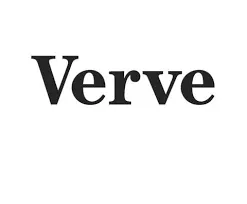





Our dream is to normalise family development. For families to learn together, go on retreats together, evolve together.
Minimum Viable Parenting Course
Family Friendly Retreats
Designed by our family for yours

WANT support with
your personal growth?
Talk to us about coaching and mentorship

Meet Our Team
Evolve X is part of the Wonder & Wander ecosystem of business that put people and community first.

Sarah Pirie-Nally
Aka Wonder, Sarah has 20+ years in innovation, events, and community building. Sarah is a serial entrepreneur and growth consultant, helping businesses achieve 8-figure revenues. Author of the book "The Wonder Mindset".

Steve Pirie-Nally
Aka Wander, Steve has 20+ years in travel, innovation, and community building. Steve is a seasoned corporate executive leading large organizations in human capability and performance. Steve has extensive experience in scaling and selling businesses.
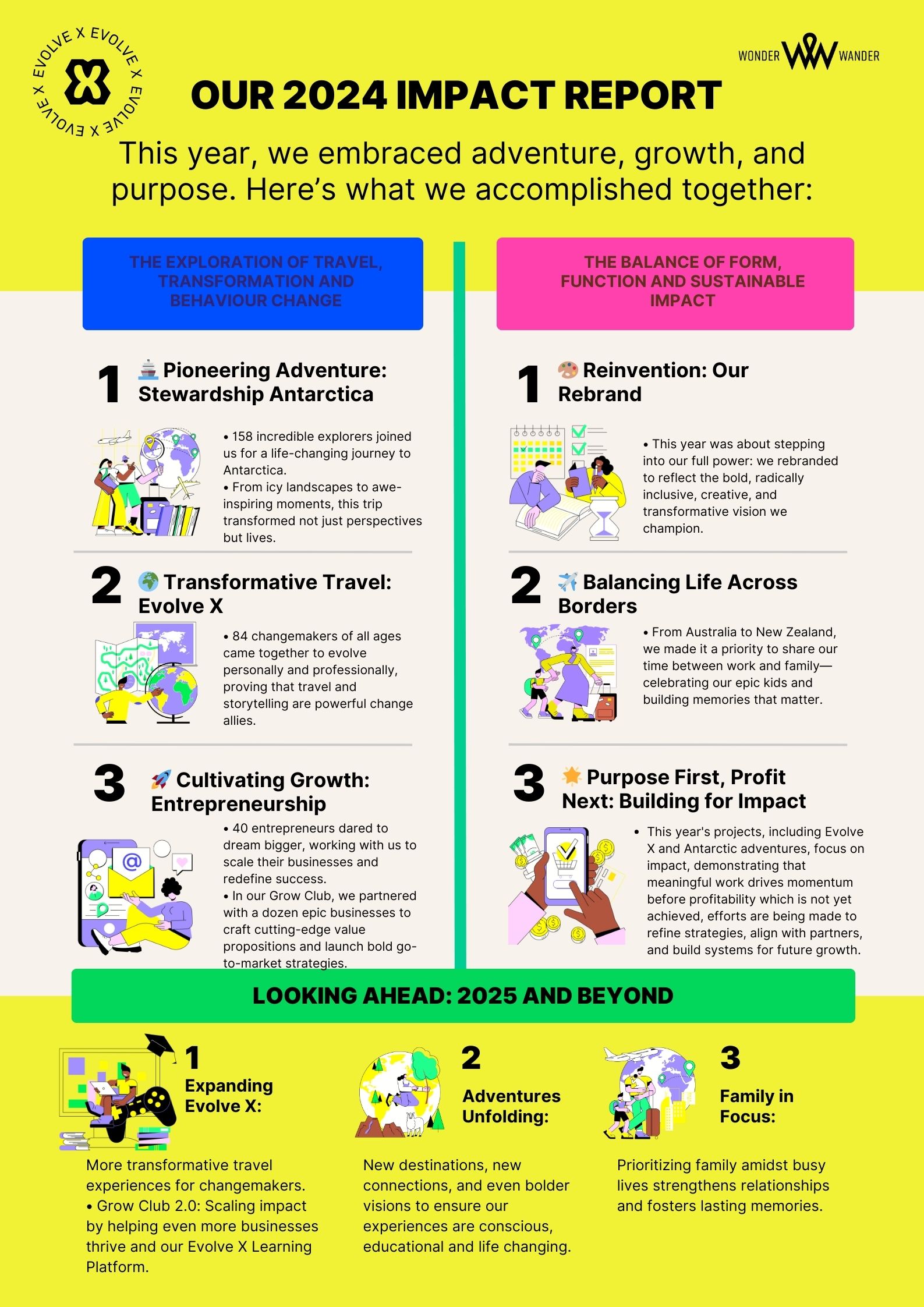
Our impact report.
This was 2024.
From scaling mountains (and businesses) to navigating family life across borders, we’ve learned that the best growth comes from leaning into bold ideas and sometimes messy challenges.
Here’s what drives us:
Purpose-Fueled Innovation: Creating experiences that inspire personal and professional evolution.
Radical Connection: Building communities that foster authentic relationships and collaboration.
Growth with Integrity: Balancing big dreams with sustainability, always with impact in mind.
This year, we’ve loved seeing our vision take shape—from launching transformative adventures to helping entrepreneurs rewrite their success stories. Thank you for being part of our journey. Together, we’re making wonder our way of life!
WHAT WE ARE PLANNING.
Hello 2025!
2025 is set to be our year of bold moves and meaningful impact. We’re doubling down on amplifying growth, nurturing relationships, and preparing for our biggest adventures yet. Here’s what’s on the horizon:
Stewardship Adventures
Evolve X Community Growth
Cultivating Growth: Coaching & The Grow Club 2.0
Evolving Families: Together Week + Evolve X OS
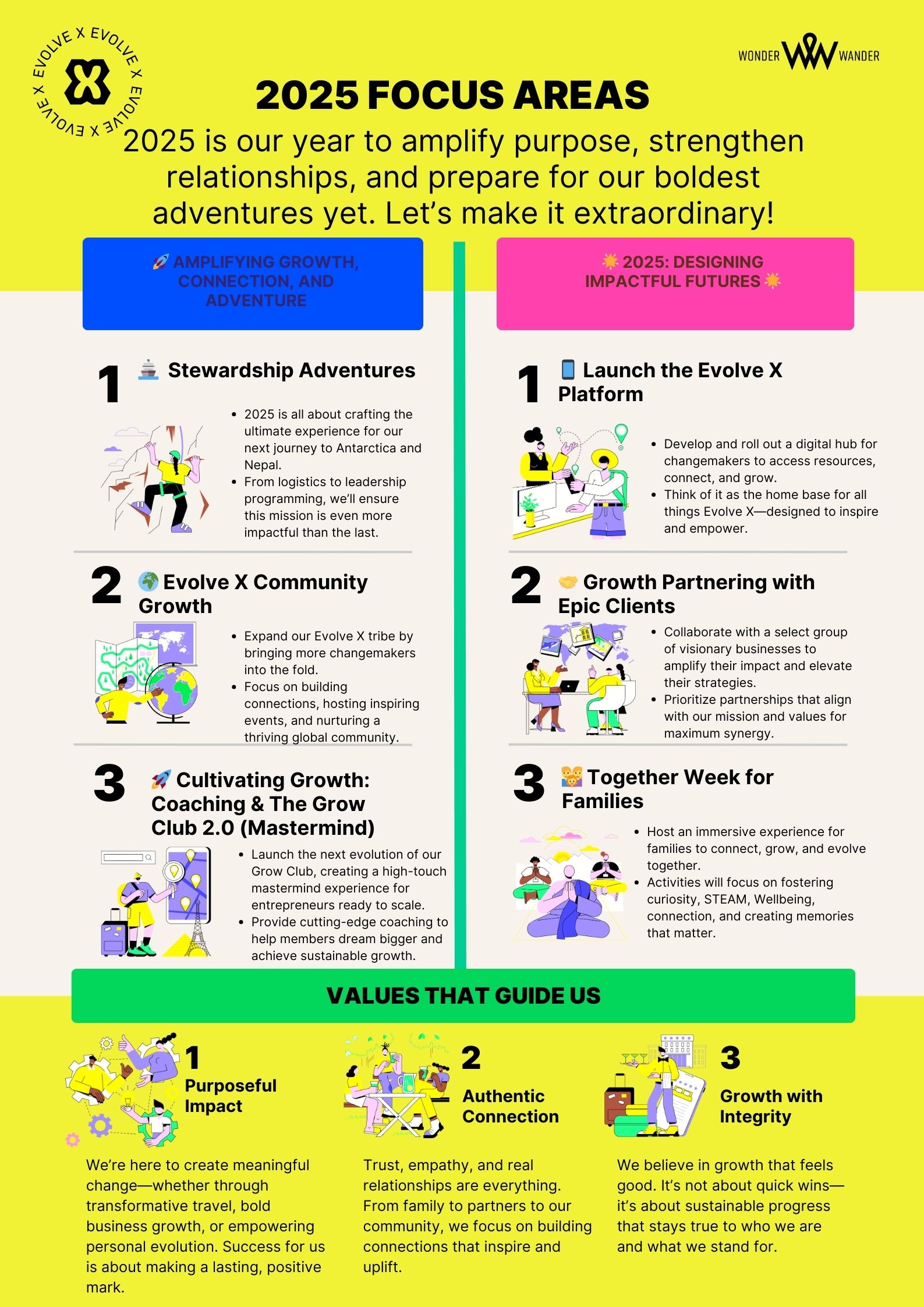
GET THE WONDER
MINDSET BOOK
In The Wonder Mindset, Sarah Pirie-Nally invites readers on a transformative journey to tap into their innate sense of wonder. Blending principles of neuropsychology, design thinking, and human-centered innovation, this book empowers you to break free from limiting beliefs, embrace curiosity, and explore new possibilities.
Rather than offering rigid formulas for success, it serves as a catalyst for personal growth, encouraging you to unlock your potential by nurturing creativity, resilience, and joy. With playful yet profound insights, The Wonder Mindset inspires readers to see life as an ever-evolving adventure where change is an opportunity for wonder, not a destination.


GET THE WONDER
MINDSET BOOK
In The Wonder Mindset, Sarah Pirie-Nally invites readers on a transformative journey to tap into their innate sense of wonder. Blending principles of neuropsychology, design thinking, and human-centered innovation, this book empowers you to break free from limiting beliefs, embrace curiosity, and explore new possibilities.
Rather than offering rigid formulas for success, it serves as a catalyst for personal growth, encouraging you to unlock your potential by nurturing creativity, resilience, and joy. With playful yet profound insights, The Wonder Mindset inspires readers to see life as an ever-evolving adventure where change is an opportunity for wonder, not a destination.
PODCAST COMING SOON...


Stay Connected
Copyright © 2024 Evolve X – All Rights Reserved





